In Berlin, flavors of Turkey and Lebanon spice up the fast food
As we are now in Berlin I thought it would be fun to re-post this article I wrote in 2003. I have uploaded a bunch of photos, both old and new. I am happy to say all the currywurst places are still here–and still sinfully good!
BERLIN — Isn’t it fitting that the country that gave us hamburgers and frankfurters
now consumes fast food from Turkey and Lebanon? Doener from Turkey and
shawarma from Lebanon — tasty sandwiches using spiced meat carved from a rotating spit — feed Berliners of all ethnicities.
Comfort foods accompany emigres the world over, and Germany is no exception.
What once was exotic fare is now to Germans what pizza and bagels are to
Americans — just another fast food with personality.
Standing alone or tucked into little shops with windows opening to the street, imbiss, or snack stands, are ubiquitous in Berlin. Patrons can save their euros for the more expensive evening meals and get freshly made hot sandwiches, which are meals in themselves, for as little as 2.50 euros (about $2.70). Most imbiss have no seating; patrons stand at tall bistro tables. Seating means the establishment is required to provide restroom facilities. But how long can you linger when there’s no place to sit?
At Winterfeldt Platz in the Schoeneberg district, Habibi’s is known for its shawarma and falafel. Its engaging Lebanese owner, who has been in Germany for 12 years, makes no adjustments for the German palate. Layers of boned and skinned chicken are marinated in spices and pressed together. After steaming, the huge funnel-shaped concoction is slowly roasted, gyrating on a spit under intense heat. An onion sits atop it to add flavor. Young men carve thin slices of chicken from the spit onto flat bread.
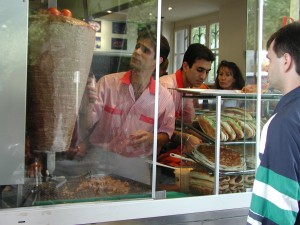
French fries and pickles nestle against the chicken. After a dressing of tangy yogurt, the bread is wrapped around the ingredients. Habibi’s is clean and lively. Fresh fruit juices, yogurt drinks, and desserts are also available. You will be full for no more than about $4.30. If you can, go on a Wednesday or Saturday before 3 p.m., when the market on the plaza in front is in full swing.
The friendly shopkeeper at the Istanbul Grill near the Buelowstrasse station has adjusted to German palates by adding more vegetables and sauces to his doeners, which in Turkey are mostly meat. Served on flat bread that closes around steaming ingredients, the doeners at the Istanbul Grill have a garlic sauce and use different herbs.
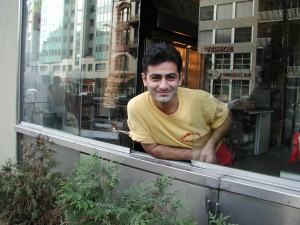
Step up to the window and ask for a doener or choose another of his Turkish specialties, like the lahmacun, a pizzalike snack sprinkled with spiced ground meat, lemon, and paprika. Nothing costs more than a few euros. Eat while you walk, or stand inside the shop.
How about a little curry with your wurst? Currywurst, Berlin’s specialty, is a sausage served ”ohne darm” (without the casing) or ”mit darm” (in the casing). It is sliced and served on a paper plate with a sweet, spicy variety of ketchup and generous sprinklings of curry and paprika. No currywurst meal would be complete without salty fried potatoes.
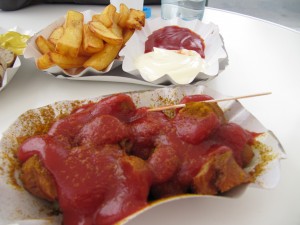
Berliners love their currywurst and line up for it outdoors at imbiss stalls all over the city. With their elbows propped on chest-high tables, diners stand and pierce their steaming wurst with a long, two-pronged fork.
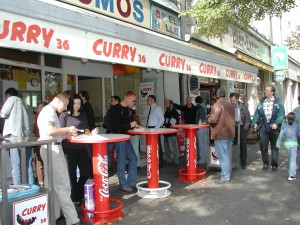
Curry 36 is a family-owned business on Mehringdamm, a broad boulevard in the Kreuzberg district. Home to the largest Turkish community in Berlin, Kreuzberg is slightly off the tourist trail but is a lively neighborhood where funky antique and secondhand clothing shops line the streets. Weave your way around laundromats. Step into a baeckerei and take in the savories and sweets of a
neighborhood bakery. Delicatessens, mom-and-pop produce shops, and bars and cafes filled with students line the street. Curry 36 has won numerous ”best currywurst in town” awards, and its famous sauce is homemade. The smell of frying potatoes and onions is an aromatic magnet. Serpentine lines at all hours attest to the popularity of this place. No problem for a hungry night owl: Curry 36 is open until 4 a.m. Take the U7 subway (called the U-Bahn) to Mehringdamm. Have your fill of currywurst, explore the neighborhood, visit Viktoria Park on Kreuzbergstrasse, where you can see a waterfall and climb to the top of the hill to view all of Berlin spread out below Karl Schinkel’s imposing monument.
You can get some of the best fries and currywurst in town at the outdoor Fritz & Co. on the fashionable Kurfuerstendamm, known as the Ku’damm (roughly comparable to Boston’s Boylston and Newbury streets). Here the potatoes are from organic farms, thick-cut, and still in their skins.
A sign says the wurst comes from happy pigs: free range and well fed.Shoppers in fancy leather jackets share standing-room-only spots with workers taking a break. Many of the imbiss and outdoor cafes on the Ku’damm have conical heaters perched on tall stands.
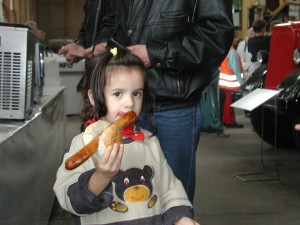
Wurst is found on most menus across the city. Unlike American hot dogs that are completely encased in soft rolls, these sausages are eaten on crusty rolls called broetchen that barely surround the meat. You chomp your way through a few crisp inches before finding the bread. A smear of spicy mustard and a local beer complete the experience. After strolling around the city, rest your feet by taking a seat at a local cafe. The kartoffelsuppe, a hearty potato soup (again with wurst), a slice of dark German whole-grain bread, and a beer are satisfying and won’t leave you stuffed or with empty pockets. In your wanderings, don’t fail to stop into a bar for a Berliner Weisse, the sweet concoction of draft beer spiked with a shot of raspberry or green syrup (traditionally served during the summer, but order it anyway). Don’t let the garish colors put you off.
The food hall in the elegant Kaufhaus des Westens department store (nicknamed KaDeWe) on the Ku’damm is not to be missed. Spectacular displays tantalize with chocolates, smoked fish, cured meats, and a staggering range of mustards, interspersed with food bars that offer champagne and caviar or apple streudel. Teddy-bear jars of mustards, honey, and chocolate spreads evoke Berlin’s mascot. Packages of dark pumpernickel rounds and tubes of sharp mustard all make wonderful, inexpensive gifts.
A visit to the new Berlin Jewish Museum, designed by Daniel Libeskind, is both an architectural and intellectual experience. The museum looks at Jewish life in Germany over many centuries, and though it does not dwell on the Holocaust, its memory is ever present. (Libeskind is the son of survivors.) The subway stop is Hallesches Tor.
Reminders of World War II are part of the city’s landscape. The decapitated Kaiser Wilhelm Memorial Church, with its ruined steeple, stands unreconstructed in the city’s center; modern planners have made no attempt to smooth over the bullet holes in the magnificent Victory Column off the Tiergarten park.
Be vigilant. Look up and down as you tour Berlin. You could easily miss a small, rusting plaque embedded in the sidewalk reminding you of citizens who were torn from their homes.
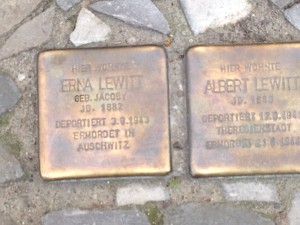
The new Reichstag building, with its glass dome, is meant to show that Germany is now a transparent democracy. It is worth a visit.
It is hard to believe Berlin was split by an unbreachable wall only 14 years ago. Today one moves effortlessly, unaware of crossing from east to west. From an outdoor cafe on the Unter den Linden in the former communist East, look through the Brandenburg Gate and watch a dramatic sunset of pinks and oranges settle on this lively city.
Debra Samuels writes about food and travel for the Food section of the Globe.

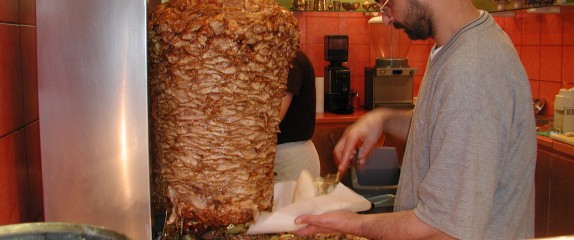
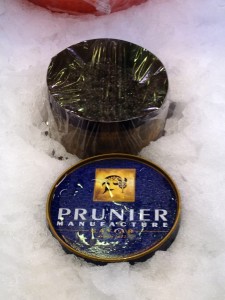
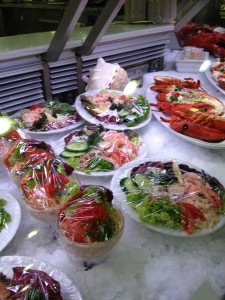
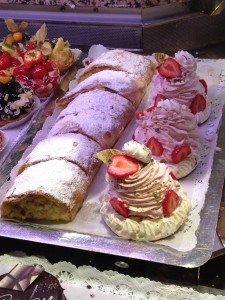
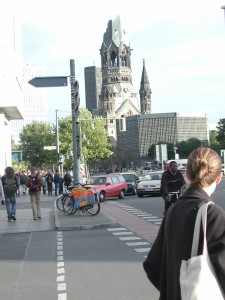
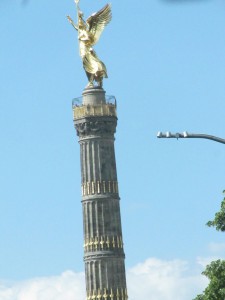









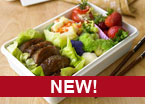 Debra Samuels, bestselling author, food writer and cooking instructor,
Debra Samuels, bestselling author, food writer and cooking instructor, 


